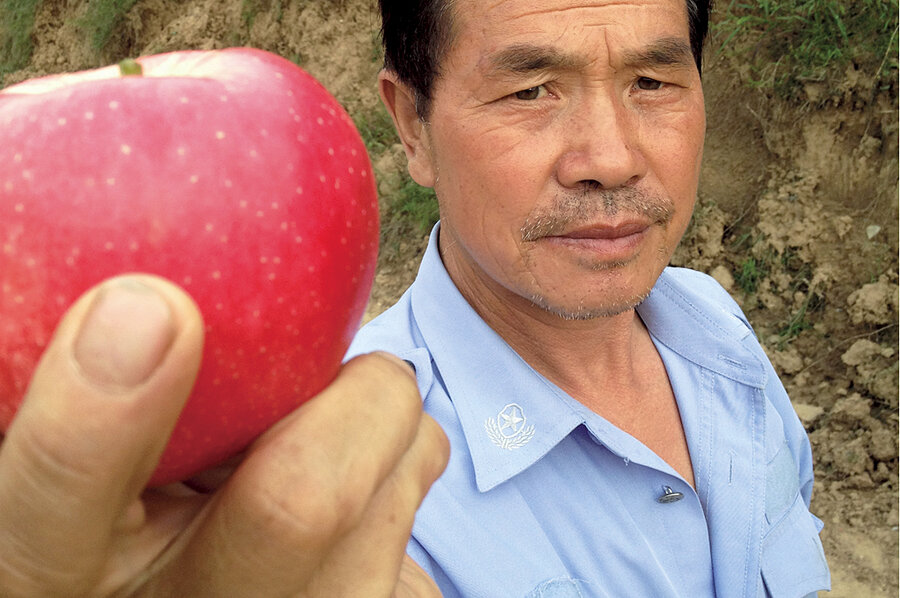Follow your labels: American apple juice is a product of China
Loading...
| Luochuan, china
My bus from Xi'an, China, passed by the giant apple-shaped structure on the edge of the city of Luochuan. At the core of the apple is an empty convention center; next to it is the apple museum and apple hotel. All this anticipates an apple tourist boom to match the apple-production explosion here.
Across the aisle on the bus, a grandfather – Feng Zi Han – held his chubby-cheeked baby granddaughter. He is an apple farmer; and when we got off the bus, he invited me to visit his farm.
Nearly 60 percent of apple juice sold in the United States is imported from China, according to US Department of Agriculture data. That's why I went there last August: I wanted to see what that meant for Chinese apple farmers. So I took Mr. Feng up on his offer.
I could barely hear the invitation over the pounding jackhammers and the swinging picks. Every road in town was being widened.
"All the apple farmers are buying cars, and we need bigger streets," Feng explained.
The next day he took me to visit the orchard. He didn't have a car yet, but he did have a motorcycle with a trailer on the back in which he placed a wooden stool for me to sit on. He handed me a pink parasol to block the sun.
His orchard sits close enough to a brand-new electric station that the hum is audible. The trees were smaller than the apple trees I've come to know in the Midwest. They didn't look as if they were growing apples at all: Small brown paper bags were used to cover each apple, warding off pests.
Feng has been farming this land for more than 20 years, but things really started to change in the 1990s, when the government began developing the region's apples and brought in scientists to teach the locals modern techniques.
The Fengs go back five generations as farmers, but they haven't always grown apples. Farmers here were subsistence farmers and herders. Their land, located on the Loess Plateau, had rich soil, but it was easily washed away. As deforestation increased, so did erosion. Desertification set in, which the World Bank referred to as "not a natural phenomenon, but one caused by the hopelessness of poverty."
In 1994, the World Bank and China launched one of the largest development projects on earth to reclaim the land. Dams were constructed; terraces were carved out by hand. Apple trees were planted. Rain that once had washed away land and flooded the region with poverty now nourishes the apple trees and brings wealth. Incomes have doubled, unemployment has halved, and ecological balance has been regained. More than 2.5 million people's lives changed.
"Growing up, we didn't have enough food," Feng said. "In 1960 in China ... we were hungry."
We left the orchard to have lunch in his home, which sits behind a brick wall with a grand metal gate decorated with a dragon knocker. I was shown into one of the four bedrooms and asked to sit on the couch. Above the couch was a sign that translated to "Family, Harmony, Fortune, and Luck."
"How has life changed?" I asked.
"Life has changed for the better," Feng said, as he unbuttoned his shirt and patted his belly. "Our living conditions are good, just look…." He motioned to his flat-screen TV and surround-sound speakers. Also on the wall were pictures of his three children – not just snapshots, but full-on glamour shots.
Feng earns about $20,000 a year growing apples, a sum that has afforded his children the opportunity to study in the city and pursue careers outside agriculture.
When Chinese apple juice concentrate entered the US market, the price of concentrate collapsed from $153 per ton in 1995 to $55 per ton in 1998. American farmers struggled to compete. Some sold their farms; others went bankrupt.
Their loss was Feng's gain.
"What percent of your apples are eaten and what percent are made into juice?" I asked.
"Seventy percent are taken to the local juice factory," he said, and then laughed. "You know, nobody here drinks apple juice."






